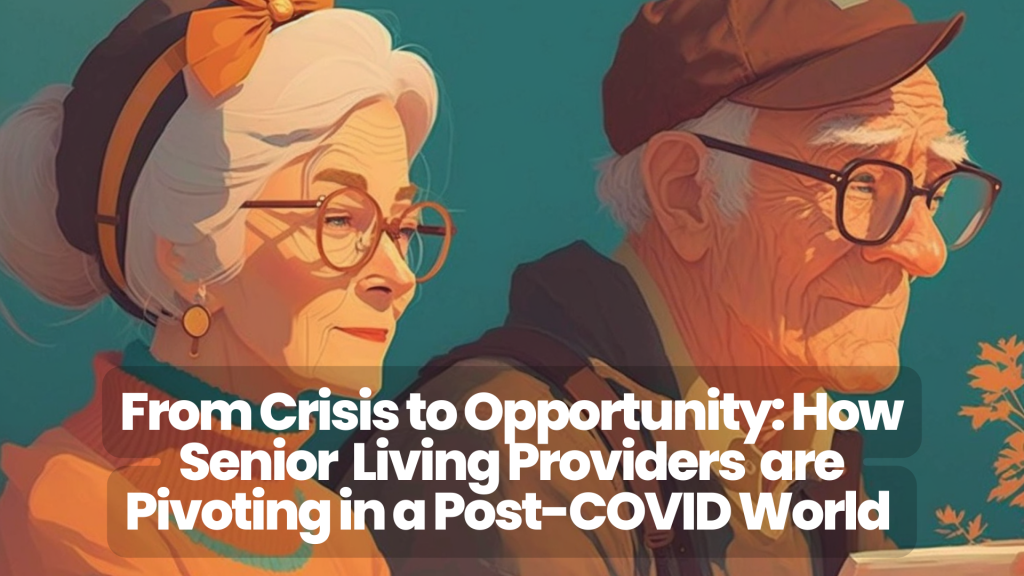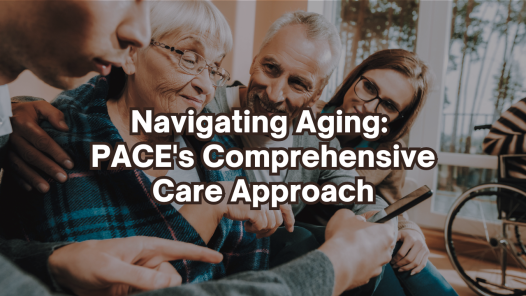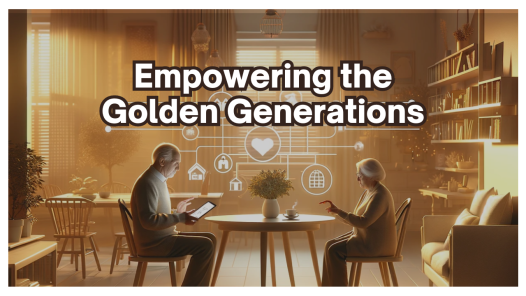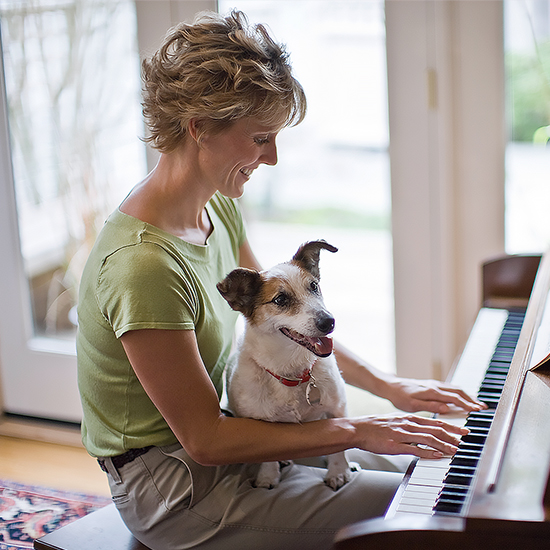
“From Crisis to Opportunity: How Senior Living Providers are Pivoting in a Post-COVID World” is a thought-provoking episode that dives into the transformative strategies employed by senior living providers to adapt and flourish amidst the challenges of a post-pandemic era.
In this series, we delve into a broad range of tactics, from the creation of smaller, flexible spaces to repurposing existing properties, exploring the profound shift in how healthcare facilities are being imagined and executed. Listeners will gain insights into how providers are using technology to enhance safety measures, improve services, and offer innovative virtual events and activities.
One key theme we tackle is the increased focus on incorporating outdoor amenities and green spaces, reflecting the heightened demand for nature access and wellness-focused facilities. We also discuss the rise of private units and intergenerational cohousing communities, which offer a fresh perspective on fostering a sense of community.
On the financial side, we dig into the exploration of new financing options, government programs, and impact investing. We also highlight providers’ partnerships with local and state governments, a crucial factor in navigating the challenges brought about by the pandemic.
We also took a critical look at delays in entitlement and zoning processes due to economic uncertainty, and the importance of emergency preparedness and disaster planning in this new landscape.
Overall, this episode offers a comprehensive examination of the senior living industry’s resilience and innovation, providing listeners with an enriching understanding of the sector’s evolution in the face of unprecedented change.
Join us as we explore these compelling topics and more.
👉 See our Website: https://podcast.boomerliving.tv/
🎙 Boomer Living Podcast: https://hanhdbrown.com/
👉 LinkedIn https://bit.ly/2TFIbbd
Transcript:
Welcome to our podcast. So today we’re going to discuss a topic that has affected everyone. The COVID-19 pandemic. Among the many industries impacted, senior living providers have faced significant challenges. So in this episode, we’ll explore how senior living providers have adapted to the changing circumstances and discovered
opportunities to enhance resident care. We’ll delve into the creative strategies and solutions being employed to meet the needs of the post covid society. So join us as we discuss from Crisis to Opportunity, How Senior Living Providers are Pivoting in the Post Covid World. So let’s talk about senior living strategies for moving forward. The industry has confronted numerous
challenges due to the COVID-19 pandemic. Ensuring the safety and health of residents and staff is of utmost importance requiring providers to develop innovative strategies to progress in this new landscape. So let’s explore some strategies that providers are implementing as they adjust to the new normal. Well first, senior living providers are
collaborating with healthcare providers to create integrated communities. By partnering with healthcare providers, senior living communities can offer more comprehensive and integrated care, providing medical services and rehabilitation programs right on site. This collaboration can lead to improved health outcomes for seniors, reduce healthcare costs,
and increase resident satisfaction. Now this partnership ensures a more streamlined and accessible experience for residents with essential services conveniently located within the communities. The integration of healthcare services also encourages more personalized care and a focus on preventative measures to maintain residents well-being.
Another approach involves concentrating on smaller, more manageable projects like pocket neighborhoods. These close-knit communities of approximately 12 to 20 homes, promote a sense of community, helping seniors stay connected with their neighbors, and providing access to amenities and services they might not have otherwise. Pocket neighborhoods are designed
to encourage social interaction while maintaining residents’ privacy and independence. These communities often feature shared outdoor spaces such as gardens and walking paths, which, um, contribute to a higher quality of life and overall well-being for seniors. So in a cost effective move, senior living providers are repurposing
existing properties such as hotels and office buildings. This not only saves on development costs, but also enables a quicker move-in process while taking advantage of existing infrastructure and amenities. The adaptive reuse of these buildings allows providers to address the demand for senior housing more rapidly and efficiently, while minimizing the
environmental impact of new construction. Now, repurposing existing properties often result in unique and architectural interesting spaces, making them more appealing to potential residants. Technology plays a crucial role in senior living providers progress. Virtual tours help seniors and their families make informed decisions without physically visiting the commuinity.
Telehealth services improved resident safety during the pandemic by reducing the need for in-person visits. Electronic health records and remote monitoring devices also assist providers in managing the resident’s health more effectively. The integration of technology into senior living communities also extend the use of smart home devices and wearables, which
can help monitor the residents’ health and safety while promoting independence. Now, technology can facilitate communication between residents and their families, enhancing social connections and providing a peace of mind for their loved ones. Also, implementing enhanced safety measures is so critical for senior living providers.
Frequent cleaning and disinfection protect residents from the virus while staff training and education ensures that providers follow the latest safety protocols. Screening protocols and visitors restrictions further reduce the risk of transmission. And by maintaining a strong focus on safety, providers can help alleviate
concerns about infection control and create an environment in which residents feel secure and protected. So the commitment to safety also extends to emergency preparedness with providers developing and refining plans for dealing with natural disasters, power outages, and other unexpected events. As the senior living industry continues to adapt, uh, to the challenges
brought on by the Covid Pandemic, it’s so important to prioritize the residents’ needs and devise creative strategies to address those needs. Strategies include incorporating healthcare service, adding outdoor amenities, offering private units, incorporating technology, and creating intergenerational communities. Senior living providers also
face financial challenges when developing and managing communities. So they have to explore new financing options, work with the local and state government, and investigate the impact of investing to overcome these challenges. Now the design and layout of the communities play a critical role in the residents health and well-being. Changing the design and layout using
modular construction, creating flexible spaces, and building a suburban and rural areas are strategies that providers are considering when designing and laying out their communities. And by prioritizing accessibility, natural light, and connections to nature, providers are creating environments that promote physical and mental well-being for their residents.
Incorporating spaces for social interaction, exercise, and relaxation can contribute to higher quality of life and encourage a sense of community within the senior living developments. So during the COVID-19 pandemic, fostering a sense of community has become crucial in senior living. Providers are employing various strategies to promote social connections among the
residents, including creating a sense of community with social distancing in place, incorporating outdoor common areas, offering virtual events and activities, and establishing intergenerational co-housing communities. While these efforts can combat feelings of isolation and loneliness that many seniors have experienced during the pandemic, while promoting
overall well-being and mental health. As you know, health and wellness are so important for seniors’ well-being. Providers are enhancing the health and wellness by incorporating wellness programs, creating spaces for quiet reflection and relaxation, and focusing on emergency preparedness and disaster planning.
So offering a variety of fitness classes, educational programs, and wellness focused activities, all of this can help residents maintain their physical and cognitive abilities while also providing opportunities for social engagement. They’re promoting a holistic approach to wellness that includes mental, emotional, and spiritual well-being. Now, all of this contributes
to a more fulfilling and a meaningful lifestyle for seniors. Affordability and accessibility play a crucial role in senior living as they directly impact the quality of life for older adults. Providers in the industry are working diligently to enhance these aspects, ensuring seniors from various financial backgrounds have access to
suitable housing and care options. One of the primary ways providers are addressing affordability is concentrating on affordable housing projects. These initiatives aim to develop communities that cater to seniors with different income levels, making it possible for more individuals to find housing that fits their budget. And by offering housing options
at various price points, providers can, um, providers are making senior living more accessible and inclusive. They’re also actively exploring new funding sources and government programs to improve affordability for senior living. And by tapping into alternative financing options, providers receive the necessary funding to construct
and maintain affordable communities. Uh, government programs such as tax incentives and subsidies help bridge the gap between the seniors financial capabilities and the cost of living in these communities. Flexible lease terms and payment options are being introduced by providers to cater to the seniors diverse financial needs. And by offering adjustable lease
agreements and customizable payment structures, providers are accommodating a wider range of income levels, making senior living more accessible to those who might not have been able to afford it, otherwise. Another component, uh, transportation services play a significant role in enhancing accessibility for seniors as they directly impact
the resident’s ability to access, uh, amenities and services. So providers are actively providing transportation solutions, helping residents maintain their independence and engage in community activities even when they have limited mobility, or can no longer drive themselves. So this also encourages social interaction and a sense of belonging among residents
which can contribute to improved mental health and overall well-being. Financial counseling is another important service offered by senior living providers aiming to help empower seniors to make informed decisions regardless of their finances. By providing guidance on budgeting, managing expenses, and navigating the financial assistance programs,
providers are helping residents maximize their resources and live comfortably within their means. Home healthcare services play a critical role in enhancing the accessibility of care for seniors as they allow residents to receive the support they need within the comfort of their home. Providers are offering these services to ensure that seniors
have access in professional care, even if they have limited mobility or face challenges in accessing the external healthcare facilities. So home healthcare services can range from nursing care and therapy to assistance with daily living activities, making it possible for seniors to maintain their independence and enjoy a higher quality of life.
So by addressing affordability and accessibility, senior living providers are ensuring that a diverse range of seniors, regardless of their financial circumstances, have access to quality housing and care options. So this approach not only benefits the individual residents, but contributes to the development of more inclusive and diverse communities
where seniors from all walks of life can come together and share their experiences and support one another. So as you can see, affordability and accessibility are a crucial aspect of senior living that the providers are prioritizing to cater to this diverse needs of age of the aging population. And by focusing on affordable housing
projects, exploring new funding sources and government programs, offering flexible lease terms and payment options, providing transportation services, offering financial counseling, and supplying home healthcare services providers are creating more inclusive and diverse communities where seniors can thrive regardless of their financial circumstances.
Now, as you know, the senior living industry has faced challenges such as delays and cancellation of housing projects due to the pandemic and the economic uncertainty. Providers are overcoming these challenges by exploring alternative financing options, working with the local governmens, and reevaluating development plans.
And by staying nimble in adapting to changing market conditions, providers can continue to meet growing demand for senior housing and care options. The pandemic has resulted in significant changes in the demand for senior living communities emphasizing the importance of healthcare, wellness, outdoor space, access to nature. Providers are prioritizing these
aspects to meet the evolving needs of their residents. And by focusing on creating communities that support physical, emotional, and mental well-being, providers can ensure that their residents continue to thrive in a post covid world. Safety measures play a critical role in senior living communities, and the providers are taking all
the steps to ensure the well-being and security of their residents. They’re actively implementing enhanced cleaning and disinfection protocols, which involve rigorous cleaning schedules, the use of high quality disinfectants, and frequent sanitization, and high-touch services. And by maintaining a clean and sanitary environment, providers minimize the
risk of infections and diseases, providing a peace of mind to both the residents and their families. Another aspect of safety that providers are addressing is the integration of backup power systems. These systems are so important in case of power outages, ensuring that residents have access to the essential services and utilities during emergencies.
And by installing and maintaining reliable backup power solutions, providers ensure that residents can continue to receive care and support even during unforeseen circumstances. Emergency response plans are also being developed and implemented by senior living providers, highlighting their commitment to the safety and security of the residents.
Comprehensive emergency plans include evacuation procedures, communication strategies, and resource management, ensuring that communities can respond effectively to emergencies and minimize potential risk. Staff members receive regular training to familiarize themselves with emergency protocols, enabling them to act promptly and efficiently in times of crisis.
Aside from the focus on safety, senior living providers are exploring innovative approaches to create new living options for seniors. Well, one approach is shared housing model, which includes co-housing and home sharing arrangements. These models provide seniors with a more affordable and socially connected living environments, fostering
a sense of community and belong. And by offering shared housing options, providers cater to seniors’ diverse needs and preferences by promoting social interaction and support among the residents. Modular construction is another innovative approach that providers are utilizing to meet the growing demands of senior housing.
By employing this method, providers can significantly reduce building costs and construction timelines. Modular construction involves the offsite fabrication of building components, which are then transported to the construction site for assembly. This process not only saves time and money, but also results in a more efficient use of resources, making
it a sustainable and cost effective solution for senior living communities. So as you can see, disaster preparedness plans are being developed by providers, ensuring that their communities are equipped to handle emergencies and protect the residents during the crisis. These comprehensive plans cover, uh, aspects such as risk assessment, resource allocation, staff training,
and communication strategies. And by having a well thought out disaster preparedness plan in place, providers demonstrate their commitment to the safety and well-being of their residents even in the most challenging circumstances. Alternative financing options are another area that providers are actively exploring, aiming to secure the necessary funding to develop and maintain high
quality senior living communities. Public and private partnerships and impact investing are examples of innovative financing solutions that providers are using to fund their projects. Public-private partnerships involve collaborations between government entities and private organizations, leveraging the strengths and resources of both sectors to achieve common goals.
Impact investing on the other hand, refers to investments made with the intention of generating both financial returns and positive social or environmental outcomes. And by considering these alternative finance financing options, senior living providers can access the capital they need to create and sustain exceptional communities for seniors. So as you can see, senior living
providers are actively implementing safety measures and exploring innovative approaches to address the diverse needs of their residents. And by focusing on enhanced cleaning and disinfection protocols, incorporating backup power systems, developing emergency response plans, offering shared housing options, utilizing modular construction, preparing disaster plans, and exploring
alternative financing options, providers create safe, secure, and high quality living environments for seniors. Their ongoing commitment to innovation and safety ensures that senior living communities remain reliable and attractive options for older adults and their families, instilling confidence and trust in the care that they provide.
So, in conclusion, senior living providers have demonstrated resilience and creativity in navigating the challenges posed by the COVID-19 pandemic. They have adopted new technologies, implemented strict safety protocols, and prioritized resident engagement and quality of life. So as the pandemic continues to shape the senior living industry, providers
are remaining adaptable and responsive to the evolving needs of their residents. And by prioritizing health, safety, and well-being, senior living providers can ensure that they continue to offer valuable services and support to the seniors in the post covid world. Well, so thank you so much for joining us in this episode as we discuss the ways that senior living providers
are pivoting in a post covid world. We hope that this discussion has shed light on the innovative strategies and solutions being employed to meet the needs of seniors in a changing society. So stay tuned for more insightful conversations on our podcast. So until next time, take care and have a great day.











